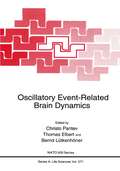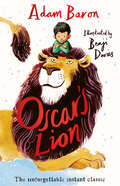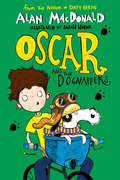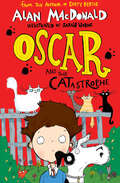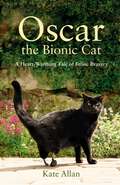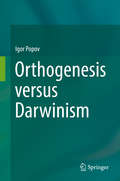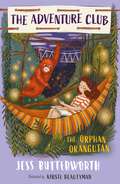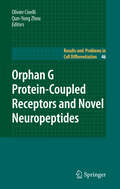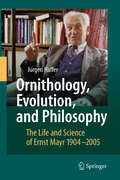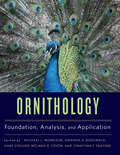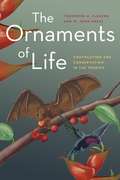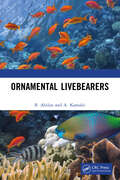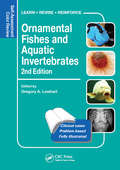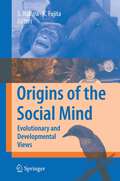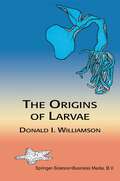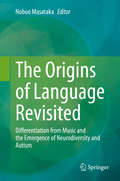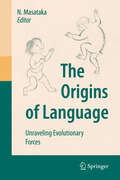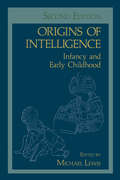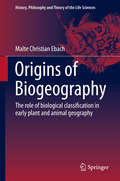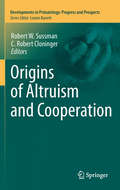- Table View
- List View
Oscillatory Event-Related Brain Dynamics (Nato Science Series A: #271)
by Christo Pantev Thomas Elbert Bernd LütkenhönerHow does the brain code and process incoming information, how does it recog nize a certain object, how does a certain Gestalt come into our awareness? One of the key issues to conscious realization of an object, of a Gestalt is the attention de voted to the corresponding sensory input which evokes the neural pattern underly ing the Gestalt. This requires that the attention be devoted to one set of objects at a time. However, the attention may be switched quickly between different objects or ongoing input processes. It is to be expected that such mechanisms are reflected in the neural dynamics: Neurons or neuronal assemblies which pertain to one object may fire, possibly in rapid bursts at a time. Such firing bursts may enhance the synaptic strength in the corresponding cell assembly and thereby form the substrate of short-term memory. However, we may well become aware of two different objects at a time. How can we avoid that the firing patterns which may relate to say a certain type of move ment (columns in V5) or to a color (V 4) of one object do not become mixed with those of another object? Such a blend may only happen if the presentation times be come very short (below 20-30 ms). One possibility is that neurons pertaining to one cell assembly fire syn chronously. Then different cell assemblies firing at different rates may code different information.
Oscar’s Lion
by Adam BaronA magical coming-of-age story about a boy spending his first weekend without his parents . . . and the lion who comes to babysit him. Get ready to fall in love with this instant classic.
Oscar and the Dognappers (Ask Oscar Ser.)
by Alan MacDonaldThe second book in a brilliantly funny new series from bestselling Dirty Bertie author Alan MacDonald, about a boy and his incredible talking dog. Oscar's back … and he's got plenty to talk about! Sam had a very ordinary life, until Oscar the dog arrived on his doorstep. Because Oscar has a big secret – he can talk!
Oscar and the CATastrophe (Ask Oscar Ser. #3)
by Alan MacDonaldThe third book in a brilliantly funny new series for 6+ readers from bestselling Dirty Bertie author Alan MacDonald, about a boy and his incredible talking dog. Sam had a very ordinary life, until Oscar the dog arrived on his doorstep. Because Oscar has a big secret – he can talk!
Oscar: A Heart-Warming Tale of Feline Bravery
by Kate AllanWhen Kate’s beloved cat, Oscar, is found with both hind legs severed by a combine-harvester, Noel Fitzpatrick, star of Channel 4's The Supervet, agrees to try pioneering surgery to replace his legs with prosthetics. This is the amazing account of a feline destined to become the world’s first bionic cat.
Orthogenesis versus Darwinism
by Igor PopovThis book reviews the convoluted history of orthogenesis with an emphasis of non-English sources, untangles relationships between various concepts of directed evolution and argues whether orthogenesis has something to offer modern biology. Darwinism claims that evolution occurs by selection from an extensive random variability. An alternative viewpoint—that the material for variability is limited and organisms are predisposed to vary in certain directions—is the essence of evolutionary concepts that can be grouped together under the name of orthogenesis. Dating back to Lamarck, orthogenesis has existed in many guises. Branded as mystical and discarded as unscientific, it keeps re-emerging in evolutionary discussions.
The Orphan Orangutan: Book 4 (The Adventure Club #4)
by Jess ButterworthDo you like exploring, animals and adventure? Then join The Adventure Club! A new illustrated series for younger readers about animals and adventure from much-loved author Jess Butterworth - writer of classic adventure stories in vibrantly described settings.It's time for the fourth Adventure Club trip, and this time Tilly and the Adventure Club are off to Borneo. When the team find an orphan orangutan alone in the wild after a fire, they rescue it and the baby orangutan takes a special liking to Tilly. But can the Adventure Club train to the baby to live in the wild without her mum? And if they do, how will Tilly ever be able to leave her behind? Join the Adventure Club to find out!Packed full of illustrations and set as Tilly's own diary, this new series is perfect for young readers who are beginning to read on their own.
Orphan G Protein-Coupled Receptors and Novel Neuropeptides (Results and Problems in Cell Differentiation #46)
by Olivier Civelli Qun-Yong ZhouOver the last decade it has been shown that orphan G protein-coupled receptors (GPCRs) can be used as targets to discover novel neuropeptides. A dozen neuropeptides have been identified through this approach. Each of these neuropeptides has opened new doors for our understanding of fundamental physiological or behavioral responses. For example the orexins, MCH and ghrelin carry fundamental roles in regulating food intake while neuropeptide S, neuromedin S, the prokineticins and the orexins are major players in modulating sleep and circadian rhythms. The chapters of this book review the latest research in the field, most of them are written by the original discoverers of the respective novel neuropeptide. Emphasis is set not only on their discovery but also on their functional significance. Since many of these neuropeptides are part of drug discovery programs, this book impacts academic as well as pharmaceutical research.
Ornithology, Evolution, and Philosophy: The Life and Science of Ernst Mayr 1904-2005
by Jürgen HafferThis book is the first detailed biography of Ernst Mayr. He was an ‘architect’ of the Synthetic Theory of Evolution, and the greatest evolutionary biologist since Charles Darwin, influential historian and philosopher of biology, outstanding taxonomist and ornithologist, and naturalist. He is one of the most widely known biologists of the 20th century. Mayr used the theories of natural selection and population thinking as theoretical models within the framework of historical biological studies. He was the first to emphasize the role of biopopulations, thereby pointing out the basic difference between ’population thinking’ and typological essentialism.
Ornithology: Foundation, Analysis, and Application
by Michael L. Morrison Amanda D. Rodewald Gary Voelker Melanie R. Col;³n Jonathan F. PratherAves, the birds, is the wildlife group that people most frequently encounter. With over 10,000 species worldwide, these animals are part of our everyday experience. They are also the focus of intense research, and their management and conservation is a subject of considerable effort throughout the world. But what are the defining attributes that make a bird a bird?Aimed at undergraduate and graduate students, Ornithology provides a solid modern foundation for understanding the life and development of birds. Written by renowned experts from around the globe, this comprehensive textbook draws on the latest research to create an innovative learning experience. Moving beyond bones, muscle, and feathers, it provides the core information needed to "build" the bird, linking anatomy and physiology with ecology and behavior.As it reviews the major orders of birds, the book highlights their wide diversity and critically evaluates ornithological concepts and theories. Incorporating brief biographies of leaders in the field, the text describes their contributions in the context of key historical events in bird science. Each chapter ends with a summary of the material covered, a discussion of potential management and conservation applications, and suggested study questions that will stimulate thought and discussion. Contributors: Peter Arcese, George E. Bentley, Lori A. Blanc, William M. Block, Alice Boyle, Leonard A. Brennan, Luke K. Butler, Zac Cheviron, Luis M. Chiappe, Melanie R. Col;³n, Caren B. Cooper, Robert J. Cooper, Jamie M. Cornelius, Carlos Martinez Del Rio, John Dumbacher, Shannon Farrell, Maureen Flannery, Geoffrey Geupel, Patricia Adair Gowaty, Thomas P. Hahn, Ashley M. Heers, Fritz Hertel, Geoffrey E. Hill, Matthew Johnson, Lukas F. Keller, Dylan C. Kesler, Pablo Sabat Kirkwood, John Klicka, Christopher A. Lepczyk, Ashley M. Long, Scott R. Loss, Graham R. Martin, John M. Marzluff, Susan B. McRae, Michael L. Morrison, Timothy J. O;€™Connell, Jen C. Owen, Marco Pavia, Jeffrey Podos, Lars Pomara, Jonathan F. Prather, Marco Restani, Alejandro Rico-Guevara, Amanda D. Rodewald, Vanya G. Rohwer, Matthias Starck, Michael W. Strohbach, S. Mažeika P. Sullivan, Diego Sustaita, Kerri T. Vierling, Gary Voelker, Margaret A. Voss, Jeff R. Walters, Paige S. Warren, Elisabeth B. Webb, Michael S. Webster, Eric M. Wood, Robert M. Zink, Benjamin Zuckerberg
Ornithology: Foundation, Analysis, and Application
by Michael L. Morrison Amanda D. Rodewald Gary Voelker Melanie R. Col;³n Jonathan F. PratherAves, the birds, is the wildlife group that people most frequently encounter. With over 10,000 species worldwide, these animals are part of our everyday experience. They are also the focus of intense research, and their management and conservation is a subject of considerable effort throughout the world. But what are the defining attributes that make a bird a bird?Aimed at undergraduate and graduate students, Ornithology provides a solid modern foundation for understanding the life and development of birds. Written by renowned experts from around the globe, this comprehensive textbook draws on the latest research to create an innovative learning experience. Moving beyond bones, muscle, and feathers, it provides the core information needed to "build" the bird, linking anatomy and physiology with ecology and behavior.As it reviews the major orders of birds, the book highlights their wide diversity and critically evaluates ornithological concepts and theories. Incorporating brief biographies of leaders in the field, the text describes their contributions in the context of key historical events in bird science. Each chapter ends with a summary of the material covered, a discussion of potential management and conservation applications, and suggested study questions that will stimulate thought and discussion. Contributors: Peter Arcese, George E. Bentley, Lori A. Blanc, William M. Block, Alice Boyle, Leonard A. Brennan, Luke K. Butler, Zac Cheviron, Luis M. Chiappe, Melanie R. Col;³n, Caren B. Cooper, Robert J. Cooper, Jamie M. Cornelius, Carlos Martinez Del Rio, John Dumbacher, Shannon Farrell, Maureen Flannery, Geoffrey Geupel, Patricia Adair Gowaty, Thomas P. Hahn, Ashley M. Heers, Fritz Hertel, Geoffrey E. Hill, Matthew Johnson, Lukas F. Keller, Dylan C. Kesler, Pablo Sabat Kirkwood, John Klicka, Christopher A. Lepczyk, Ashley M. Long, Scott R. Loss, Graham R. Martin, John M. Marzluff, Susan B. McRae, Michael L. Morrison, Timothy J. O;€™Connell, Jen C. Owen, Marco Pavia, Jeffrey Podos, Lars Pomara, Jonathan F. Prather, Marco Restani, Alejandro Rico-Guevara, Amanda D. Rodewald, Vanya G. Rohwer, Matthias Starck, Michael W. Strohbach, S. Mažeika P. Sullivan, Diego Sustaita, Kerri T. Vierling, Gary Voelker, Margaret A. Voss, Jeff R. Walters, Paige S. Warren, Elisabeth B. Webb, Michael S. Webster, Eric M. Wood, Robert M. Zink, Benjamin Zuckerberg
The Ornaments of Life: Coevolution and Conservation in the Tropics (Interspecific Interactions)
by Theodore H Fleming W. John KressThe average kilometer of tropical rainforest is teeming with life; it contains thousands of species of plants and animals. As The Ornaments of Life reveals, many of the most colorful and eye-catching rainforest inhabitants—toucans, monkeys, leaf-nosed bats, and hummingbirds to name a few—are an important component of the infrastructure that supports life in the forest. These fruit-and-nectar eating birds and mammals pollinate the flowers and disperse the seeds of hundreds of tropical plants, and unlike temperate communities, much of this greenery relies exclusively on animals for reproduction. Synthesizing recent research by ecologists and evolutionary biologists, Theodore H. Fleming and W. John Kress demonstrate the tremendous functional and evolutionary importance of these tropical pollinators and frugivores. They shed light on how these mutually symbiotic relationships evolved and lay out the current conservation status of these essential species. In order to illustrate the striking beauty of these “ornaments” of the rainforest, the authors have included a series of breathtaking color plates and full-color graphs and diagrams.
The Ornaments of Life: Coevolution and Conservation in the Tropics (Interspecific Interactions)
by Theodore H Fleming W. John KressThe average kilometer of tropical rainforest is teeming with life; it contains thousands of species of plants and animals. As The Ornaments of Life reveals, many of the most colorful and eye-catching rainforest inhabitants—toucans, monkeys, leaf-nosed bats, and hummingbirds to name a few—are an important component of the infrastructure that supports life in the forest. These fruit-and-nectar eating birds and mammals pollinate the flowers and disperse the seeds of hundreds of tropical plants, and unlike temperate communities, much of this greenery relies exclusively on animals for reproduction. Synthesizing recent research by ecologists and evolutionary biologists, Theodore H. Fleming and W. John Kress demonstrate the tremendous functional and evolutionary importance of these tropical pollinators and frugivores. They shed light on how these mutually symbiotic relationships evolved and lay out the current conservation status of these essential species. In order to illustrate the striking beauty of these “ornaments” of the rainforest, the authors have included a series of breathtaking color plates and full-color graphs and diagrams.
The Ornaments of Life: Coevolution and Conservation in the Tropics (Interspecific Interactions)
by Theodore H Fleming W. John KressThe average kilometer of tropical rainforest is teeming with life; it contains thousands of species of plants and animals. As The Ornaments of Life reveals, many of the most colorful and eye-catching rainforest inhabitants—toucans, monkeys, leaf-nosed bats, and hummingbirds to name a few—are an important component of the infrastructure that supports life in the forest. These fruit-and-nectar eating birds and mammals pollinate the flowers and disperse the seeds of hundreds of tropical plants, and unlike temperate communities, much of this greenery relies exclusively on animals for reproduction. Synthesizing recent research by ecologists and evolutionary biologists, Theodore H. Fleming and W. John Kress demonstrate the tremendous functional and evolutionary importance of these tropical pollinators and frugivores. They shed light on how these mutually symbiotic relationships evolved and lay out the current conservation status of these essential species. In order to illustrate the striking beauty of these “ornaments” of the rainforest, the authors have included a series of breathtaking color plates and full-color graphs and diagrams.
Ornamental Livebearers
by B. Ahilan A. KamaliiThis textbook on Ornamental Livebearers is a comprehensive guide and deals with the culture and breeding of livebearers. The present status of ornamental fish farming and new technologies on the breeding and culture of livebearers have also been aptly dealt with. A wide range of aspects such as, anatomy of livebearers, important livebearers and their breeding, feed and feeding management, water quality management, disease management biosecurity and economics of livebearers fish farm have been described in detail. It is hoped that this publication presented in an easy-to-read style with a number of photographs and illustrations will be of great use to all students who have fisheries in their curriculum and also a standard guide for the researchers, entrepreneurs and ornamental fish farmers.
Ornamental Livebearers
by B. Ahilan A. KamaliiThis textbook on Ornamental Livebearers is a comprehensive guide and deals with the culture and breeding of livebearers. The present status of ornamental fish farming and new technologies on the breeding and culture of livebearers have also been aptly dealt with. A wide range of aspects such as, anatomy of livebearers, important livebearers and their breeding, feed and feeding management, water quality management, disease management biosecurity and economics of livebearers fish farm have been described in detail. It is hoped that this publication presented in an easy-to-read style with a number of photographs and illustrations will be of great use to all students who have fisheries in their curriculum and also a standard guide for the researchers, entrepreneurs and ornamental fish farmers.
Ornamental Fishes and Aquatic Invertebrates: Self-Assessment Color Review, Second Edition (Veterinary Self-Assessment Color Review Series)
by Gregory A. LewbartThis is a new edition in the Self-Assessment Colour Review series that covers ornamental fish. It includes 200 colour illustrated cases in random order, as they would be presented in practice. It presents questions based on each case with answers that fully explore the disease/disorder. This new edition contains 250 new cases. The book should appeal to candidates preparing for examinations and to practitioners in their continuing education.
Ornamental Fishes and Aquatic Invertebrates: Self-Assessment Color Review, Second Edition (Veterinary Self-Assessment Color Review Series)
by Gregory A. LewbartThis is a new edition in the Self-Assessment Colour Review series that covers ornamental fish. It includes 200 colour illustrated cases in random order, as they would be presented in practice. It presents questions based on each case with answers that fully explore the disease/disorder. This new edition contains 250 new cases. The book should appeal to candidates preparing for examinations and to practitioners in their continuing education.
Origins of the Social Mind: Evolutionary and Developmental Views
by Shoji Itakura Kazuo FujitaIncludes social cognition in birds and nonhuman primates as well as various aspects of social cognition in human children
The Origins of Larvae
by D. WilliamsonMany biological facts are irreconcilable with the assumption that larvae and adults evolved from the same genetic stock. The author of this book draws attention to these, and presents his alternative hypothesis that larvae have been transferred from one taxon to another.In his previous book (Larvae and Evolution, 1992), the author used larval transfer to explain developmental anomalies in eight animal phyla. In the present book, he claims that the basic forms of all larvae and all embryos have been transferred from foreign taxa. This leads to a new, comprehensive theory on the origin of embryos and larvae, replacing the discredited 'recapitulation' theory of Haeckel (1866). Metamorphosis, previously unexplained, represents a change in taxon during development.
The Origins of Language Revisited: Differentiation from Music and the Emergence of Neurodiversity and Autism
by Nobuo MasatakaThis book summarizes the latest research on the origins of language, with a focus on the process of evolution and differentiation of language. It provides an update on the earlier successful book, “The Origins of Language” edited by Nobuo Masataka and published in 2008, with new content on emerging topics.Drawing on the empirical evidence in each respective chapter, the editor presents a coherent account of how language evolved, how music differentiated from language, and how humans finally became neurodivergent as a species. Chapters on nonhuman primate communication reveal that the evolution of language required the neural rewiring of circuits that controlled vocalization. Language contributed not only to the differentiation of our conceptual ability but also to the differentiation of psychic functions of concepts, emotion, and behavior. It is noteworthy that a rudimentary form of syntax (regularity of call sequences) has emerged in nonhuman primates. The following chapters explain how music differentiated from language, whereas the pre-linguistic system, or the “prosodic protolanguage,” in nonhuman primates provided a precursor for both language and music. Readers will gain a new understanding of music as a rudimentary form of language that has been discarded in the course of evolution and its role in restoring the primordial synthesis in the human psyche. The discussion leads to an inspiring insight into autism and neurodiversity in humans. This thought-provoking and carefully presented book will appeal to a wide range of readers in linguistics, psychology, phonology, biology, anthropology and music.
The Origins of Language: Unraveling Evolutionary Forces
by Nobuo MasatakaDevelopments in cognitive science indicate that human and nonhuman primates share a range of behavioral and physiological characteristics that speak to the issue of language origins. This volume has three major themes, woven throughout the chapters. First, it is argued that scientists in animal behavior and anthropology need to move beyond theoretical debate to a more empirically focused and comparative approach to language. Second, those empirical and comparative methods are described, revealing underpinnings of language, some of which are shared by humans and other primates and others of which are unique to humans. New insights are discussed, and several hypotheses emerge concerning the evolutionary forces that led to the "design" of language. Third, evolutionary challenges that led to adaptive changes in communication over time are considered with an eye toward understanding various constraints that channeled the process.
Origins of Intelligence: Infancy and Early Childhood
by Michael LewisSince the first edition of this volume was published in 1976, interest in the problem of intelligence in general and infant intelligence in particu lar has continued to grow. The response to the first edition was hearten ing: many readers found it a source of information for the diverse areas of study in infant intelligence. Because of the success of that volume, we have decided to issue a second edition. This edition is in many ways both similar to and different from the first. Its similarity lies in the fact that many of the themes and many of the contributors remain the same. Its difference can be found in the updating of old chapters and the addition of several new ones. Taken together, the chapters present a rounded picture of the cen tral issues in infant intelligence. Because the aim was to present a picture of the issues, no attempt, other than the selection of authors and themes, can be made to integrate these chapters into a single coherent whole. In large part, this reflects the diversity of study found in the area of early intellectual behavior. Rather than having a comprehensive theo ry of infant intelligence, the field abounds with a series of critical ques tions. To unite these chapters into some coherence, it will be necessary to articulate what these issues might be. Five major themes run through out the field of infant intelligence and thus through this volume.
Origins of Biogeography: The role of biological classification in early plant and animal geography (History, Philosophy and Theory of the Life Sciences #13)
by Malte Christian EbachThis book presents a revised history of early biogeography and investigates the split in taxonomic practice, between the classification of taxa and the classification of vegetation. It moves beyond the traditional belief that biogeography is born from a synthesis of Darwin and Wallace and focuses on the important pioneering work of earlier practitioners such as Zimmermann, Stromeyer, de Candolle and Humboldt.Tracing the academic history of biogeography over the decades and centuries, this book recounts the early schisms in phyto and zoogeography, the shedding of its bonds to taxonomy, its adoption of an ecological framework and its beginnings at the dawn of the 20th century. This book assesses the contributions of key figures such as Zimmermann, Humboldt and Wallace and reminds us of the forgotten influence of plant and animal geographers including Stromeyer, Prichard and de Candolle, whose early attempts at classifying animal and plant geography would inform later progress.The Origins of Biogeography is a science historiography aimed at biogeographers, who have little access to a detailed history of the practices of early plant and animal geographers. This book will also reveal how biological classification has shaped 18th and 19th century plant and animal geography and why it is relevant to the 21st bio geographer.
Origins of Altruism and Cooperation (Developments in Primatology: Progress and Prospects #36)
by Robert W. Sussman and C. Robert CloningerThis book is about the evolution and nature of cooperation and altruism in social-living animals, focusing especially on non-human primates and on humans. Although cooperation and altruism are often thought of as ways to attenuate competition and aggression within groups, or are related to the action of “selfish genes”, there is increasing evidence that these behaviors are the result of biological mechanisms that have developed through natural selection in group-living species. This evidence leads to the conclusion that cooperative and altruistic behavior are not just by-products of competition but are rather the glue that underlies the ability for primates and humans to live in groups. The anthropological, primatological, paleontological, behavioral, neurobiological, and psychological evidence provided in this book gives a more optimistic view of human nature than the more popular, conventional view of humans being naturally and basically aggressive and warlike. Although competition and aggression are recognized as an important part of the non-human primate and human behavioral repertoire, the evidence from these fields indicates that cooperation and altruism may represent the more typical, “normal”, and healthy behavioral pattern. The book is intended both for the general reader and also for students at a variety of levels (graduate and undergraduate): it aims to provide a compact, accessible, and up-to-date account of the current scholarly advances and debates in this field of study, and it is designed to be used in teaching and in discussion groups. The book derived from a conference sponsored by N.S.F., the Wenner-Gren Foundation for Anthropological Research, the Washington University Committee for Ethics and Human Values, and the Anthropedia Foundation for the study of well-being.
